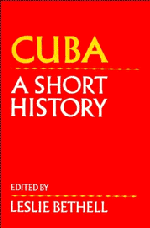2 - Cuba, c. 1860–c. 1930
Published online by Cambridge University Press: 05 June 2012
Summary
In the 1860s, Cuba, the richest and most populated of Spain's two remaining American colonies, faced serious economic and political problems. The period of sustained growth, which beginning in the late eighteenth century had transformed the island into the world's foremost sugar producer, had begun to slow down during the previous decade. The production and export of sugar, the colony's staple product, continued to expand, but growing competition from European and American sugar beet and the development of new sugar-cane producing regions posed a threat to the future.
Since the 1840s, conscious of that threat, many alert hacendados (sugar-mill owners) began efforts to modernize (essentially to mechanize) the industry, while doubling their demands for reform of the archaic colonial commercial system. Spain economic weakness, and specifically her lack of sugar refineries and inability to absorb Cuba's sugar production, increasingly revealed Cuba's colonial dilemma: growing economic dependence on markets and technology which her mother country could not provide.
Furthermore, the future of slavery, for centuries an essential element in sugar production, had become bleak. The slave trade to Cuba had been declared illegal by treaties between Spain and Britain in 1817, but the trade managed to continue until 1835, when another treaty between the two nations and stricter vigilance on the part of the Spanish authorities forced it to decline yearly. By 1860 the infamous trade had virtually disappeared. During the 1840s and 1850s, some hacendados had placed their hopes for continued slavery on annexation by the United States, and had even helped to organize armed US expeditions to Cuba, but the victory of the North in the American civil war put an end to that particular brand of annexationist thought.
- Type
- Chapter
- Information
- CubaA Short History, pp. 21 - 56Publisher: Cambridge University PressPrint publication year: 1993
- 1
- Cited by



